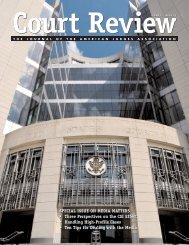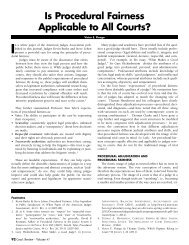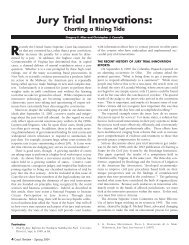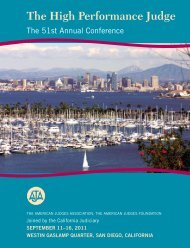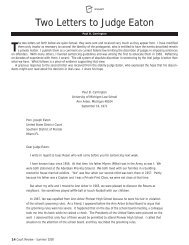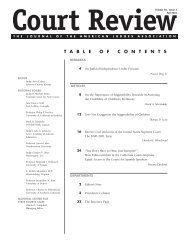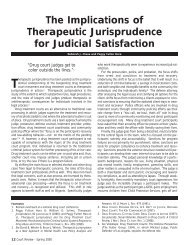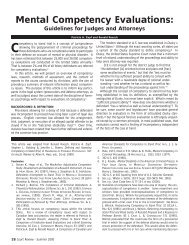Decisi<strong>on</strong> Makers andDecisi<strong>on</strong> Recipients:Understanding Disparities in the Meaning of <strong>Fairness</strong>Diane Sivasubramaniam & Larry HeuerSince World War II, psychologists have devoted c<strong>on</strong>siderableattenti<strong>on</strong> to understanding the factors that shapepeople’s satisfacti<strong>on</strong> with the outcomes of social or ec<strong>on</strong>omicexchanges—outcomes of events not unlike the encountersoccurring between judges and litigants in civil and criminalcourtrooms, encounters between police officers and civilians,or encounters between mediators and disputants in alternativedispute resoluti<strong>on</strong> centers throughout the United Statesevery day. In <strong>on</strong>e classic early study, it came as somewhat of asurprise when it was discovered that satisfacti<strong>on</strong> was not easilyexplained by ec<strong>on</strong>omic theories of human behavior. 1 Thisfinding launched an inquiry guided by theories and empiricalresearch that has c<strong>on</strong>tinued to this day.In this article, we offer an overview of the major developmentsin these theories and the accompanying research with aneye toward their implicati<strong>on</strong>s for understanding the factors thatshape citizens’ satisfacti<strong>on</strong> with the U.S. legal system. Then, wenote that the vast majority of this research has focused primarily<strong>on</strong> <strong>on</strong>ly a porti<strong>on</strong> of the individuals who are engaged in thelegal encounters that are taking place—the subordinates (thelitigants, and civilians, and disputants whose outcomes arebeing decided) rather than the authorities (the judges, policeofficers, and mediators who are deciding the cases), and wedescribe some recent research suggesting that the satisfacti<strong>on</strong> ofdecisi<strong>on</strong> makers might be guided by different principles thanthe satisfacti<strong>on</strong> of those who receive their decisi<strong>on</strong>s.DEVELOPMENT OF PROCEDURAL FAIRNESS RESEARCHIn an extensive body of research <strong>on</strong> the psychology of fairness,psychologists have investigated factors that determinepeople’s satisfacti<strong>on</strong> with c<strong>on</strong>flict resoluti<strong>on</strong> processes. Earlyresearch <strong>on</strong> the psychology of fairness focused <strong>on</strong> distributivefairness. These early studies examined people’s beliefs that theoutcomes of their c<strong>on</strong>flicts were fair, and showed that disputants’satisfacti<strong>on</strong> with c<strong>on</strong>flict resoluti<strong>on</strong> was more str<strong>on</strong>glyinfluenced by the fairness than the favorability of the outcomesthey received. 2 However, research <strong>on</strong> the psychology of fairnessshifted to a focus <strong>on</strong> procedural fairness when Thibaut andWalker dem<strong>on</strong>strated that disputants’ satisfacti<strong>on</strong> with c<strong>on</strong>flictresoluti<strong>on</strong> was influenced by the fairness of the c<strong>on</strong>flict resoluti<strong>on</strong>procedures, as well as the fairness of the outcomes producedby those procedures. 3Importantly, Thibaut and Walker showed that disputantsjudged procedures to be fair to the extent that they felt theywere granted “voice” or input into the procedure, and influenceover the process. Their theory of procedural fairnessposited that process c<strong>on</strong>trol was a critical determinant of disputants’judgments of procedural fairness and satisfacti<strong>on</strong>.Since this research was c<strong>on</strong>ducted in high c<strong>on</strong>flict settings(simulated legal disputes), it was assumed that disputants valued“voice” or process c<strong>on</strong>trol because they were motivated toobtain fair outcomes, and therefore preferred procedures thatpermitted them to express their views and to be influential inshaping those outcomes.Although this theory was well supported, some findings didnot fit well with Thibaut and Walker’s reas<strong>on</strong>ing about whyvoice was important to disputants. Their procedural justicetheory predicted that process c<strong>on</strong>trol was important because ofits potential instrumental value – it increased the likelihood ofobtaining fair and beneficial outcomes. However, subsequentresearch showed that voice enhanced fairness judgments evenwhen disputants did not think their voice would influencetheir outcome. 4 This n<strong>on</strong>-instrumental voice effect led twopsychologists, Tom Tyler and E. Allan Lind, to propose a groupvalue theory of procedural fairness. This theory has profoundlyinfluenced subsequent research and theory <strong>on</strong> proceduralfairness.Tyler and Lind’s research was supportive of their claim thatcertain n<strong>on</strong>-instrumental procedural features were particularlyinfluential for people’s evaluati<strong>on</strong>s of these processes: trustworthyauthorities, neutral procedures, and respectful treatment.If disputants felt that the authority figure in a procedurewas trustworthy, the procedure was neutral, and the disputant’srights were generally respected in the procedure, then the disputantsgenerally judged the procedure to be fair. 5According to the group value model of procedural fairness,this occurs because such procedural features c<strong>on</strong>vey to disputantsthat they are valued and respected members of theirvalued social groups. When a procedure c<strong>on</strong>veys that a pers<strong>on</strong>is valued by their group, and that they are held in high regardFootnotes1. SAMUEL.A. STOUFFER ET AL., THE AMERICAN SOLDIER: ADJUSTMENTDURING ARMY LIFE § 1 (1949).2. E.g., J. Stacey Adams, Inequity in Social Exchange, in 2 ADVANCES INEXPERIMENTAL SOCIAL PSYCHOLOGY 267 (Le<strong>on</strong>ard Berkowitz ed.,1965); ELAINE WALSTER, et al., New Directi<strong>on</strong>s in Equity Research,in 9 ADVANCES IN EXPERIMENTAL SOCIAL PSYCHOLOGY 1 (Le<strong>on</strong>ardBerkowitz ed., 1976).3. JOHN THIBAUT & LAURENS WALKER, PROCEDURAL JUSTICE: APSYCHOLOGICAL ANALYSIS (1975).4. E. A. Lind et al., Voice, C<strong>on</strong>trol, and <strong>Procedural</strong> Justice: Instrumentaland N<strong>on</strong>instrumental C<strong>on</strong>cerns in <strong>Fairness</strong> Judgments, 59 J.PERSONALITY & SOC. PSYCHOL. 952 (1990).5. E.g., Tom R. Tyler & E. A. Lind, A Relati<strong>on</strong>al Model of Authority inGroups, in 25 ADVANCES IN EXPERIMENTAL SOCIAL PSYCHOLOGY 115(Mark P. Zanna ed., 1992).62 Court Review - Volume 44
y the authorities representing that social group, then that pers<strong>on</strong>will generally judge that procedure to be fair. Essentially,the group value model posits that people do not judge proceduresto be fair because those procedures deliver fair or favorableoutcomes, and people do not value procedural featureslike voice or respectful treatment because they signal the likelihoodof favorable outcomes. Rather, procedural features liketrust, neutrality, respect (and voice) c<strong>on</strong>vey important symbolicor relati<strong>on</strong>al informati<strong>on</strong> – they c<strong>on</strong>vey that the individualis respected by his or her group – prompting people tojudge those procedures as fair. 6 An extensive body of researchprovides str<strong>on</strong>g support for these central claims of the groupvalue model.Notably, the ascendancy of the group value model in theprocedural fairness literature is the culminati<strong>on</strong> of a significantshift from the parameters that defined early c<strong>on</strong>flict research.Psychologists have progressed from early ec<strong>on</strong>omic models ofsatisfacti<strong>on</strong> that focused primarily <strong>on</strong> obtaining favorable outcomes,to distributive fairness models that focused primarily <strong>on</strong>obtaining fair outcomes, to procedural fairness models thatfocused primarily <strong>on</strong> procedures as instruments for shaping fairoutcomes, to a procedural fairness model that views proceduresas an important source of largely symbolic informati<strong>on</strong>: informati<strong>on</strong>about <strong>on</strong>e’s relati<strong>on</strong>ship with valued social groups.Each of these developments has moved psychologists furtheraway from the propositi<strong>on</strong> that outcomes are critical determinantsof procedural fairness judgments.Psychologists have also dem<strong>on</strong>strated that procedural fairnessjudgments themselves have important social and legal c<strong>on</strong>sequences.For example, Tyler c<strong>on</strong>ducted large-scale surveys ofChicago, IL, and Oakland, CA, residents. 7 Across four studies,Tyler showed that process c<strong>on</strong>cerns were more important thaninstrumental c<strong>on</strong>cerns in shaping citizens’ evaluati<strong>on</strong>s of thepolice and courts. Judgments about the fairness with which thepolice and courts exercised their authority predicted citizens’c<strong>on</strong>fidence in and support for legal authorities, their perceivedobligati<strong>on</strong> to obey the law, and their willingness to cooperatewith legal authorities and legal instituti<strong>on</strong>s in the future—findingswhich have been replicated in numerous studies since Lindand Tyler proposed their groupvalue theory. 8<strong>Procedural</strong> fairness researchhas clearly dem<strong>on</strong>strated thatdisputants attach a great deal ofimportance to the way they aretreated by the authorities whorepresent legal instituti<strong>on</strong>s. 9Disputants’ evaluati<strong>on</strong>s of thelegal system are heavily influencedby their percepti<strong>on</strong> thatthey were treated fairly inencounters with judges, police,[F]airness andsatisfacti<strong>on</strong>judgments [ofdecisi<strong>on</strong> makerslike judges maynot be] dominatedby treatmentand relati<strong>on</strong>alc<strong>on</strong>cerns.and other legal authorities, and this procedural fairness effectoften trumps the effect of distributive fairness and outcomefavorability. 10 When procedural features like trust, neutrality,respectful treatment, and voice increase procedural fairnessjudgments, this functi<strong>on</strong>s as a n<strong>on</strong>-coercive means to increasecompliance with the law and cooperati<strong>on</strong> with legal authorities.NEW FINDINGS IN PROCEDURAL FAIRNESS: DECISIONMAKERS VS. DECISION RECIPIENTSSeveral studies have suggested the dominant influence ofprocedural fairness <strong>on</strong> satisfacti<strong>on</strong> may not apply equally to allactors in the legal system. Some studies suggest that, am<strong>on</strong>gdecisi<strong>on</strong> makers (e.g., judges), fairness and satisfacti<strong>on</strong> judgmentsare shaped by quite different factors and are not dominatedby treatment and relati<strong>on</strong>al c<strong>on</strong>cerns. For example,Lissak and Sheppard found that managers tended to emphasizecost and efficiency more str<strong>on</strong>gly than fairness as criteria forresolving organizati<strong>on</strong>al c<strong>on</strong>flict. 11 Some early procedural fairnessresearch also suggested that when assessing their satisfacti<strong>on</strong>with dispute resoluti<strong>on</strong> procedures or outcomes, decisi<strong>on</strong>makers were more influenced by instrumental criteria (such asc<strong>on</strong>trol over decisi<strong>on</strong>s and financial c<strong>on</strong>siderati<strong>on</strong>s), and lessc<strong>on</strong>cerned with relati<strong>on</strong>al criteria (such as treatment and trustworthiness),than were decisi<strong>on</strong> recipients 12 .One recent paper focused directly <strong>on</strong> judgments of proceduralfairness by judges. 13 Heuer and his colleagues point to6. E. A. LIND & TOM R. TYLER, THE SOCIAL PSYCHOLOGY OFPROCEDURAL JUSTICE (1988).7. Tom R. Tyler, Public Trust and C<strong>on</strong>fidence in Legal Authorities: WhatDo Majority and Minority Group Members Want From the Law andLegal Instituti<strong>on</strong>s?, 19 BEHAV. SCI. & L. 215 (2001).8. TOM R. TYLER ET AL., SOCIAL JUSTICE IN A DIVERSE SOCIETY (1997);Jas<strong>on</strong> Sunshine & Tom R. Tyler, Moral Solidarity, Identificati<strong>on</strong>with the Community, and the Importance of <strong>Procedural</strong> Justice: ThePolice as Prototypical Representatives of a Group’s Moral Values, 66SOC. PSYCHOL. Q. 153 (2003); Tom R. Tyler et al., Cultural Valuesand Authority Relati<strong>on</strong>s: The Psychology of C<strong>on</strong>flict Resoluti<strong>on</strong>Across Cultures, 6 PSYCHOL. PUB. POL’Y & L. 1138 (2000).9. NAT’L CTR. FOR STATE COURTS, HOW THE PUBLIC VIEWS THE STATECOURTS: A 1999 NATIONAL SURVEY (1999), available athttp://www.ncsc<strong>on</strong>line.org/WC/Publicati<strong>on</strong>s/Res_AmtPTC_PublicViewCrtsPub.pdf; DAVID B. ROTTMAN, TRUST AND CONFIDENCE INTHE CALIFORNIA COURTS: A SURVEY OF THE PUBLIC AND ATTORNEYS,PART I: FINDINGS AND RECOMMENDATIONS (JUDICIAL COUNCIL OFCALIFORNIA/ADMINISTRATIVE OFFICE OF THE COURTS 2005), availableat http://www.courtinfo.ca.gov/reference/documents/4_37pubtrust1.pdf;TOM R. TYLER, WHY PEOPLE OBEY THE LAW (2006).10. But see Linda J. Skitka, Do the Means Always Justify the Ends, Or Dothe Ends Sometimes Justify the Means? A Value Model of JusticeReas<strong>on</strong>ing, 28 PERSONALITY & SOC. PSYCHOL. BULL. 588 (2002).11. Robin I. Lissak & Blair H. Sheppard, Bey<strong>on</strong>d <strong>Fairness</strong>: TheCriteri<strong>on</strong> Problem in Research <strong>on</strong> Dispute Interventi<strong>on</strong>, 13 J. APPLIEDSOC. PSYCHOL. 45 (1983).12. E.g., R. H. G. Field & R. J. House, A Test of the Vroom-Yett<strong>on</strong> ModelUsing Manager and Subordinate Reports, 75 J. APPLIED PSYCHOL. 362(1990); Madeline E. Heilman et al., Reacti<strong>on</strong>s to Prescribed LeaderBehavior as a Functi<strong>on</strong> of Role Perspective: The Case of the Vroom-Yett<strong>on</strong> Model, 69 Journal of Applied Psychology 50 (1984); PaulineHoulden et al., Preference for Modes of Dispute Resoluti<strong>on</strong> as aFuncti<strong>on</strong> of Process and Decisi<strong>on</strong> C<strong>on</strong>trol, 14 J. EXP. SOC. PSYCHOL.13 (1978).13. Larry Heuer et al., The Role of Societal Benefits and <strong>Fairness</strong>C<strong>on</strong>cerns am<strong>on</strong>g Decisi<strong>on</strong> Makers and Decisi<strong>on</strong> Recipients, 31 LAW& HUM. BEHAV. 573 (2007).Court Review - Volume 44 63



